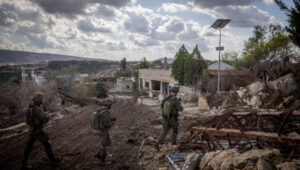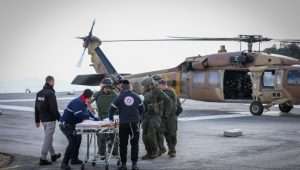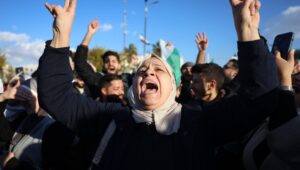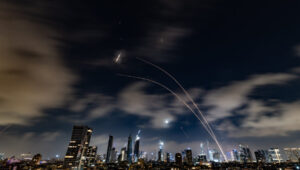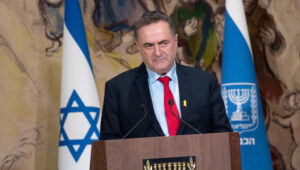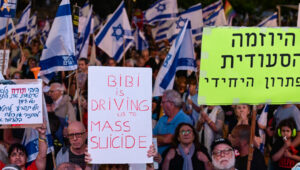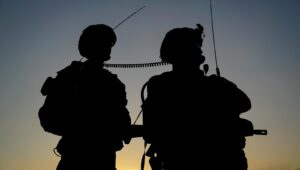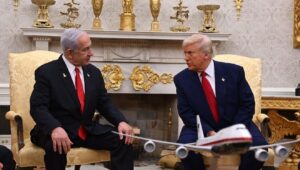This analysis is about the rapidly deteriorating situation in Syria, where the ever-increasing chaos has now also increased the likelihood of conflict between the Israeli army and the militias controlled by Iran, as you will see.
In the night from Saturday to Sunday, four Israeli F-16 warplanes carried out a new attack on a target in Syria.
The sound of the planes’ roaring engines was clearly audible in northeastern Israel, and an hour later the first reports of the new attack appeared on the media forum News Now, which keeps track of all news reports published daily in the world.
Oddly enough, the Israel Air Force (IAF) action was initially not reported by the Israeli media, as is usual.
That changed when it became known that the Israeli army was holding an unannounced surprise exercise in the far north of Israel.
The exercise was dubbed “Warm Winter 2,” and 13,000 soldiers, including 5,000 reservists, took part in the drill.
The three-day exercise, which included massive participation by the IAF, came after Israel on Saturday warned the Lebanese government that it was mulling an attack on Beirut International Airport because Iranian civilian aircraft have started transporting sophisticated weapons directly to Lebanon.
Iran is apparently looking for alternative routes to supply weapons to Hezbollah after the IAF repeatedly blocked the supply lines through Syria.
The threat of Israeli intervention
It also became clear on Sunday that the threat of Israeli intervention in Syria has become more real.
First, it became clear that the strike by the four IAF F-16 fighters was directed against a radar station in Tel Qalib near the Al-Suwayda region.
The radar was part of anti-aircraft batteries manned by Hezbollah terrorists and members of Iranian backed-militias who were disguised as Syrian army soldiers.
Al-Suwayda is also referred to as the Druze Mountain (Har HaDruzi in Hebrew) due to the fact that the population there is predominantly Druze, a community that has managed to stay out of the fray and were once on the side of the Assad regime.
The area has become the scene of serious unrest, violence and demonstrations against the regime of Syrian dictator Bashar al-Assad in recent weeks, however.
The unrest is mainly related to the enormous economic crisis in Syria, where the population now suffers not only from hunger, but also from a chronic lack of fuel to heat homes.
People are now even burning old clothes and trash in their stoves to generate some heat in their homes, while the more fortunate are using old wooden furniture for the same purpose.
Hezbollah is apparently trying to take advantage of the unrest in Al-Suwayda and has increased its presence in Tel Qalib, according to the IDF’s 210 Bashan Division, which is tasked with guarding the border with Syria on the Golan Heights.
On Sunday, leaflets were distributed from IAF aircraft warning in Arabic against cooperation with Hezbollah.
The pamphlet hinted that the IAF had been responsible for the nighttime attack on the radars in Tel Qalib, and Syrian soldiers were warned against any further collaboration with Hezbollah.
“The presence of Hezbollah in the Tel Qalib area and collaboration with them has only harmed and humiliated you. You are now paying the price for it,” the IDF said in the pamphlet.
“If you choose to support the oppressor, you are destined to suffer,” the Israeli army continued.
Hezbollah moves weapons and troops
Then there was a second indication of the possibility of Israeli intervention in southwest Syria.
Also on Sunday, Hezbollah began moving heavy weapons and troops it had stationed in the area around Damascus and from the area around the city of Halab (Aleppo).
The troops and weapons were transferred to other areas in southwest Syria, probably closer to the border with Israel.
Israeli media then reported that Hezbollah “fears” an Israeli attack, but this claim does not seem to fit with the situation on the ground.
Hezbollah has long been preparing for war with Israel and has succeeded in modernizing a part of its missile arsenal with help from Iran.
The Lebanese terror organization has also transferred its elite Radwan unit to the border with Israel in southern Lebanon.
UNIFIL, the UN peacekeeping force in Lebanon, has repeatedly warned against Hezbollah’s activities in southern Lebanon. The international peacekeeping force says it is intimidated by Hezbollah and is struggling to carry out its tasks due to the presence of the terrorist group in its mandate area.
Under UN Security Council Resolution 1702, Hezbollah is forbidden to take up positions below the Litani River in southern Lebanon, but clearly doesn’t abide by the resolution.
Hezbollah leader Hassan Nasrallah also visited Damascus two weeks ago and held talks with Assad.
Such unusual visits to Assad by the Hezbollah leadership in the past have proved to be a clear indication of imminent action against Israel.
Increasing instability in Syria
The situation in Syria is an ideal breeding ground for the terrorist organizations present, and is a recipe for more instability.
The Assad regime officially controls only a little more than 60 percent of its original pre-civil war territory in 2011, and only 15 percent of its international land borders.
The regime-controlled area is experiencing great disorder and growing unrest, however. Various players, who in the years when the civil war in Syria raged in full force controlled a large part of the country, and are now trying to use the situation to increase their influence over Syria again.
Among them is the Turkish government, which is again preparing an invasion of the border area with Syria.
The area controlled by the predominantly Kurdish Syrian Democratic Forces (SDF) has already been the scene of a Turkish invasion three times.
Turkey’s President Recep Tayyip Erdogan has now demanded Russian help in his plans for a new move against the SDF that aims to create a 30-kilometer-wide Kurd-free buffer zone along the Turkish-Syrian border.
On Sunday, Iranian media reported that the Turkish army started to carry out heavy artillery fire on SDF positions in Halab province.
In response, the SDF suspended all cooperation with the US military in order to pressure the Biden Administration to do more to constrain Erdogan.
The Turkish leader, however, seems determined to clear the border area in Syria of any Kurdish presence, and claims the region is full of “terrorists,” meaning Kurdish fighters.
At the same time, the Islamic State group (ISIS) is looking to make a comeback in Syria, and has recently stepped up its attacks in the war-torn country.
In response to increased ISIS activity in Syria, two leaders of the organization were liquidated by the US Air Force on Sunday, but the suspension of cooperation with the SDF will most likely harm the ongoing war against the remnants of the Islamic State.
ISIS has a relatively strong presence in the Dara’a Province close to the Jordanian border and isn’t threatened there by the US-led coalition.
In November, close to 50 people died in Dara’a as the result of murderous attacks by unidentified terrorists who are apparently affiliated with the ISIS network.
As for possible Israeli action against the Iranian axis in Syria, due to the further weakening of Assad’s position and the chaos in Syria, the likelihood of a confrontation between the Iranian-controlled militias in southern Syria and the IDF is growing now.




